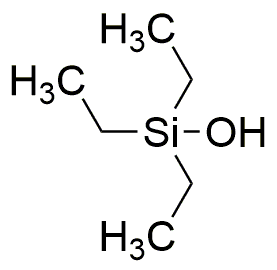Triethylsilanol is widely utilized in research focused on:
- Silicone Production: It serves as a key intermediate in the synthesis of silicone polymers, which are used in a variety of applications, including sealants, adhesives, and coatings.
- Surface Modification: This compound is effective for modifying surfaces to enhance hydrophobic properties, making it valuable in the electronics and automotive industries for improving water resistance.
- Organosilicon Chemistry: Triethylsilanol is used in the development of organosilicon compounds, which are important in pharmaceuticals and agrochemicals for their unique properties and functionalities.
- Catalysis: It acts as a catalyst in various chemical reactions, particularly in organic synthesis, providing researchers with efficient pathways for producing complex molecules.
- Personal Care Products: The compound is incorporated into formulations for cosmetics and personal care items, enhancing texture and stability while providing moisture retention benefits.
General Information
Properties
Safety and Regulations
Applications
Triethylsilanol is widely utilized in research focused on:
- Silicone Production: It serves as a key intermediate in the synthesis of silicone polymers, which are used in a variety of applications, including sealants, adhesives, and coatings.
- Surface Modification: This compound is effective for modifying surfaces to enhance hydrophobic properties, making it valuable in the electronics and automotive industries for improving water resistance.
- Organosilicon Chemistry: Triethylsilanol is used in the development of organosilicon compounds, which are important in pharmaceuticals and agrochemicals for their unique properties and functionalities.
- Catalysis: It acts as a catalyst in various chemical reactions, particularly in organic synthesis, providing researchers with efficient pathways for producing complex molecules.
- Personal Care Products: The compound is incorporated into formulations for cosmetics and personal care items, enhancing texture and stability while providing moisture retention benefits.
Documents
Safety Data Sheets (SDS)
The SDS provides comprehensive safety information on handling, storage, and disposal of the product.
Product Specification (PS)
The PS provides a comprehensive breakdown of the product’s properties, including chemical composition, physical state, purity, and storage requirements. It also details acceptable quality ranges and the product's intended applications.
Certificates of Analysis (COA)
Search for Certificates of Analysis (COA) by entering the products Lot Number. Lot and Batch Numbers can be found on a product’s label following the words ‘Lot’ or ‘Batch’.
Número de catálogo
Número de lote/lote
Certificates Of Origin (COO)
This COO confirms the country where the product was manufactured, and also details the materials and components used in it and whether it is derived from natural, synthetic, or other specific sources. This certificate may be required for customs, trade, and regulatory compliance.
Número de catálogo
Número de lote/lote
Safety Data Sheets (SDS)
The SDS provides comprehensive safety information on handling, storage, and disposal of the product.
DownloadProduct Specification (PS)
The PS provides a comprehensive breakdown of the product’s properties, including chemical composition, physical state, purity, and storage requirements. It also details acceptable quality ranges and the product's intended applications.
DownloadCertificates of Analysis (COA)
Search for Certificates of Analysis (COA) by entering the products Lot Number. Lot and Batch Numbers can be found on a product’s label following the words ‘Lot’ or ‘Batch’.
Número de catálogo
Número de lote/lote
Certificates Of Origin (COO)
This COO confirms the country where the product was manufactured, and also details the materials and components used in it and whether it is derived from natural, synthetic, or other specific sources. This certificate may be required for customs, trade, and regulatory compliance.


